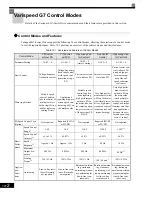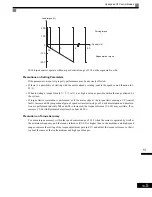
10
-10
Motor Application Precautions
This section provides precautions for motor application.
Using the Drive for an Existing Standard Motor
When a standard motor is operated with the Drive, power loss is slightly higher than when operated with a com-
mercial power supply. Observe the following precautions when using Drive for an existing standard motor.
Low Speed Ranges
Cooling effects diminish in the low-speed range, resulting in an increase in the motor temperature. Therefore,
the motor torque should be reduced in the low-speed range whenever using a motor not made by Yaskawa. If
100% torque is required continuously at low speed, consider using a special drive or vector motor.
Installation Withstand Voltage
If the input voltage is high (440 V or higher) or the wiring distance is long, the motor insulation voltage must
be considered. Contact your Yaskawa representative for details.
High-speed Operation
When using the motor at a high speed (60 Hz or more), problems may arise in dynamic balance and bearing
durability. Contact your Yaskawa representative for details.
Torque Characteristics
The motor may require more acceleration torque when the motor is operated with the Drive than when oper-
ated with a commercial power supply. Check the load torque characteristics of the machine to be used with the
motor to set a proper V/f pattern.
Vibration
The Drive uses a high carrier PWM to reduce motor vibration. (A parameter can be set to select low carrier,
PWM modulation control as well.) When the motor is operated with the Drive, motor vibration is almost the
same as when operated with a commercial power supply.
Motor vibration may, however, become greater in the following cases.
Resonance with the Natural Frequency of the Mechanical System
Take special care when a machine that has been operated at a constant speed is to be operated in variable speed
mode. If resonance occurs, install vibration-proof rubber on the motor base or use the frequency jump function
to skip any frequency resonating the machine.
Imbalanced Rotor
Take special care when the motor is operated at a higher speed (60 Hz or more).
Noise
Noise varies with the carrier frequency. At high carrier frequencies, the noise is almost the same when the
motor is operated with a commercial power supply. Motor noise, however, becomes louder when the motor is
operated at a speed higher than the rated speed (60 Hz).
Summary of Contents for CIMR-G7U
Page 2: ......
Page 7: ...v...
Page 32: ...1 18...
Page 90: ...3 16...
Page 112: ...4 22...
Page 382: ...6 164...
Page 410: ...7 28...
Page 454: ......
Page 455: ......
















































